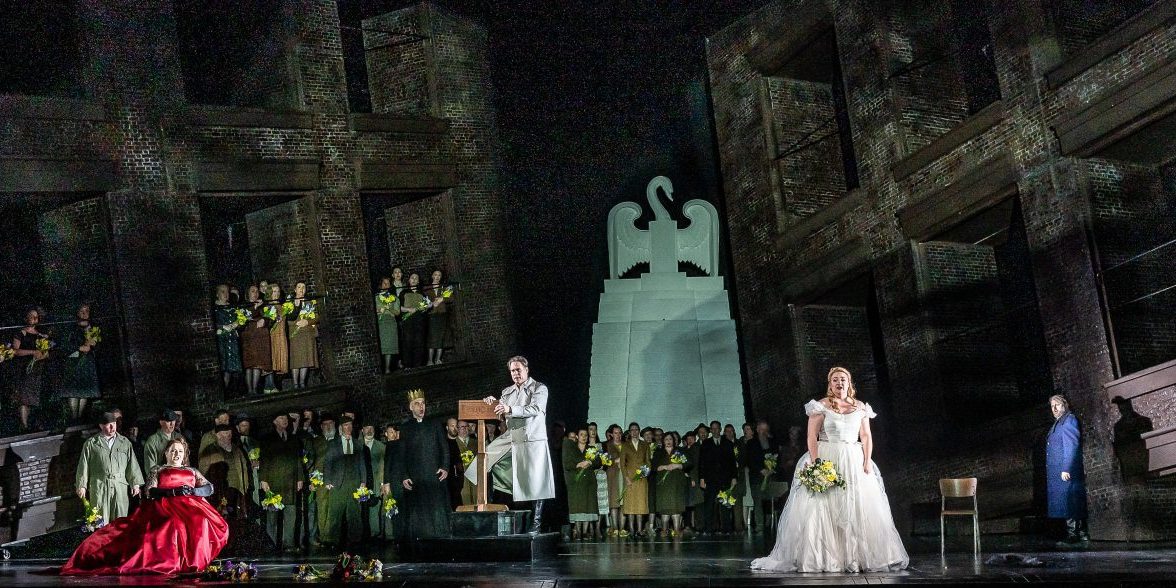‘Lohengrin’ was Wagner’s first clear masterpiece, but it is all the same an uneasy work, embodying both the culmination of one tradition of operatic writing and the beginning of the experimental ‘music of the future’, which would be realised in ‘The Ring’. On the one hand, it is a chivalric romance that takes to a culminating point the nationalist rediscovery of Germany’s medieval past; but it is also strikingly original in its orchestration, structure and psychological penetration. It is the first of Wagner’s operas to be through-written without reference to traditional sub-divisions. He also employs new instruments and new instrumental combinations to reflect and underscore the mood of the moment; and in Otrud – the chief villain of the piece – who dominates the second act and threatens to take over the whole opera, he creates an anticipation of the complex vengeful characters that populate ‘The Ring.’
Making sense of so many conflicting elements in a modern production is no easy task. David Alden’s production won plaudits four years ago for neither paying it conventionally straight nor imposing one single untraditional alternative template. This revival is a reminder of the wisdom of this approach. The unsettled and divided principality of Brabant is relocated to an early twentieth century state in a condition of dislocation, with totalitarian aspects emerging at intervals. Paul Steinberg’s sets tilt at vertiginous angles and banners and monuments evoke fascist iconography and the visual world of De Chirico. This is an apt context for the arrival of the redeemer knight, Lohengrin, ready to provide new national leadership, as well as to defend the honour of the heroine, Elsa.
Musically, the evening operates on a very high level. In the pit Jakub Hrůša balances and paces the long scenes expertly, building the climaxes carefully, and securing playing of great delicacy as well as power, with the dynamic range set by a ravishing performance of the opening prelude. There are large forces to coordinate here, particularly with off-stage bands and solo players positioned in boxes in the auditorium as well. All passed off smoothly and impressively.
The title role remains somewhat enigmatic in any production, but Brandon Jovanovich has real authority and credibility in the key scenes, such as the Grail narration, and a voice equal to the varied demands of the score. Jennifer Davis repeats her stand-out performance as Elsa from the initial run. Not only is she fully on top of its technical demands, but her acting ensures that Elsa is much more than a persecuted embodiment of passive innocence and purity.
As suggested earlier, there is a danger in this work of the villains stealing the show. Craig Colclough and Anna Smirnova as Telramund and Ortrud are both totally compelling in singing and acting, especially in the middle act. Smirnova’s gradual undermining of Elsa’s trust in Lohengrin is a fine exercise in deft insinuation – she is a real female Iago – but she has a wonderful Wagnerian power and panache to draw upon as well in the episodes of public confrontation. Gábor Bretz gives a fine-grained portrait of the cares of rulership in the role of King Henry, and Derek Welton does far more than usual with the minor role of the Herald.
This is an altogether absorbing evening, and while not every detail and gambit in this production convinces, the fact that so much care and attention is lavished on each scene is reward enough. A short review can only reference a few such moments, but two stand out. The arrival of the swan in each of the outer acts often presents problems for directors. Here delicate light projection of beating wings makes the point admirably and economically without requiring us to suspend disbelief or distracting from onward flow of the action. Even more impressive is the way in which the chorus, who are central to the success of this opera, are deployed throughout the evening. Careful thought has gone into each visual tableau, so that instead of static declamation there is continual dynamic movement whether across the stage or on multiple levels, or indeed across the fourth wall involving incursions into the orchestra stalls. In a long evening, these are very necessary and helpful interventions. As a result, the dramatic impulse rarely fades even with two intervals and a running time longer than most.

